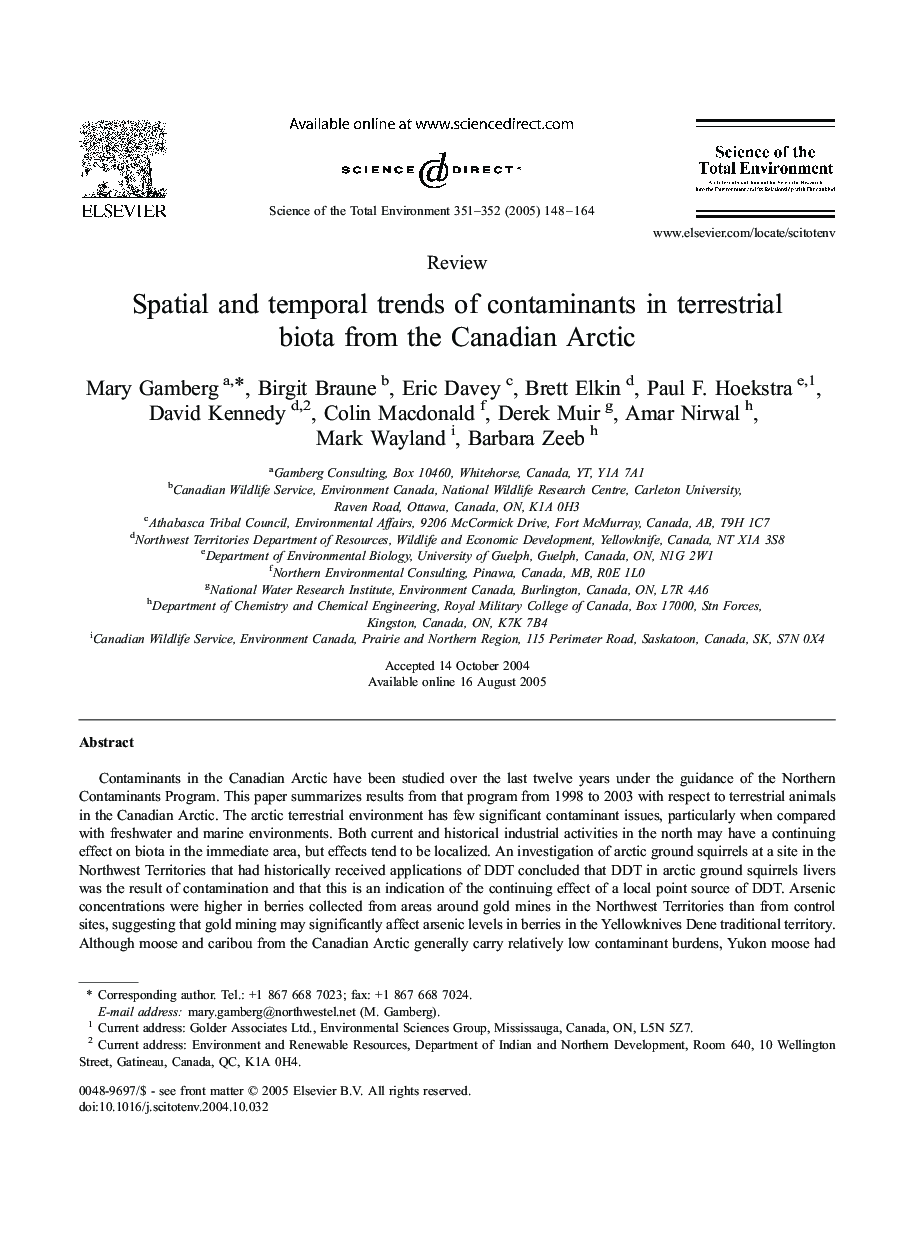| کد مقاله | کد نشریه | سال انتشار | مقاله انگلیسی | نسخه تمام متن |
|---|---|---|---|---|
| 10110566 | 1619987 | 2005 | 17 صفحه PDF | دانلود رایگان |
عنوان انگلیسی مقاله ISI
Spatial and temporal trends of contaminants in terrestrial biota from the Canadian Arctic
دانلود مقاله + سفارش ترجمه
دانلود مقاله ISI انگلیسی
رایگان برای ایرانیان
کلمات کلیدی
موضوعات مرتبط
علوم زیستی و بیوفناوری
علوم محیط زیست
شیمی زیست محیطی
پیش نمایش صفحه اول مقاله

چکیده انگلیسی
Contaminants in the Canadian Arctic have been studied over the last twelve years under the guidance of the Northern Contaminants Program. This paper summarizes results from that program from 1998 to 2003 with respect to terrestrial animals in the Canadian Arctic. The arctic terrestrial environment has few significant contaminant issues, particularly when compared with freshwater and marine environments. Both current and historical industrial activities in the north may have a continuing effect on biota in the immediate area, but effects tend to be localized. An investigation of arctic ground squirrels at a site in the Northwest Territories that had historically received applications of DDT concluded that DDT in arctic ground squirrels livers was the result of contamination and that this is an indication of the continuing effect of a local point source of DDT. Arsenic concentrations were higher in berries collected from areas around gold mines in the Northwest Territories than from control sites, suggesting that gold mining may significantly affect arsenic levels in berries in the Yellowknives Dene traditional territory. Although moose and caribou from the Canadian Arctic generally carry relatively low contaminant burdens, Yukon moose had high renal selenium concentrations, and moose and some woodland caribou from the same area had high renal cadmium levels, which may put some animals at risk of toxicological effects. Low hepatic copper levels in some caribou herds may indicate a shortage of copper for metabolic demands, particularly for females. Similarities in patterns of temporal fluctuations in renal element concentrations for moose and caribou suggest that environmental factors may be a major cause of fluctuations in renal concentrations of some elements. Concentrations of persistent organochlorines and metals in beaver and muskrat from the Northwest Territories, and carnivores from across the Canadian Arctic were very low and considered normal for terrestrial wildlife. Two new classes of persistent fluorinated contaminants, perfluorooctane sulfonate (PFOS) and perfluoroalkyl carboxylates (PFCAs) were found in arctic carnivores and were most abundant in arctic fox and least abundant in mink. Although trace element concentrations in king and common eider ducks were low and not of toxicological concern, the number of nematode parasites in common eiders was positively correlated with total and organic mercury concentrations. Future research should focus on cadmium in moose and caribou, mercury in caribou, and emerging contaminants, with an effort to sample moose and caribou annually where possible to explore the role of naturally occurring cycles in apparent temporal trends.
ناشر
Database: Elsevier - ScienceDirect (ساینس دایرکت)
Journal: Science of The Total Environment - Volumes 351â352, 1 December 2005, Pages 148-164
Journal: Science of The Total Environment - Volumes 351â352, 1 December 2005, Pages 148-164
نویسندگان
Mary Gamberg, Birgit Braune, Eric Davey, Brett Elkin, Paul F. Hoekstra, David Kennedy, Colin Macdonald, Derek Muir, Amar Nirwal, Mark Wayland, Barbara Zeeb,